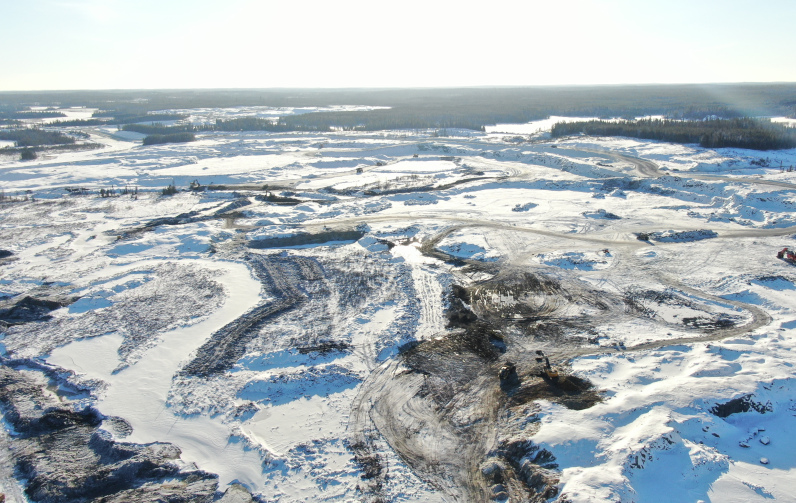The future is now
In 2022, we instituted a new section. The Net-Zero Challenge ran over the course of the year and reporter Kelsey Rolfe was put on the beat, giving her an opportunity to develop an expertise in reporting on the industry’s efforts to reduce its carbon footprint. This first installment laid out the reality of the industry’s global GHG emissions and described some of the challenges involved in addressing it. Subsequent columns examined how different aspects of the business (exploration, metallurgy, for example) were tackling the situation, how to deal with technological uncertainty, and how even accounting for emissions is fraught. – Carolyn Gruske
The clean track
CIM Magazine has been following developments at Copper Mountain mine in south central B.C. since it began producing again in 2011. Its throughput initially hobbled by particularly hard ore, the operation has since grown in scale and life. A number of innovative projects at the mine – shovel mounted XRF sensors, electric-trolley-assist haulage and a new carbon accounting framework – compelled us to check in again and the subsequent project profile by Alexandra Lopez-Pacheco nicely captures how the mine and the industry are evolving. – Ryan Bergen
A global concern
We have been covering the creation and development of the Global Tailings Review’s “Global Industry Standard on Tailings Management” ever since it was announced following the Brumadinho disaster in 2019. While it, and other standards, have done much to improve awareness of tailings management and institute new checks into the process, there are still issues that arise, especially when dealing with multiple standards simultaneously. Reporter Tijana Mitrovic delves deep into the issue, showing why the industry still lacks a complete picture of how to manage and account for tailings. While a step in the right direction, there is still much to do to protect people and the environment from any future disasters. – Matthew Parizot
U.S. Defense Production Act? Is it a big deal?
Yes, even for Canadians, the U.S. Defense Production Act is a big deal. By invoking the Act, President Biden gives the the Department of Defense increased powers to help miners and explorers secure supplies of battery minerals such as lithium, nickel, cobalt, graphite and manganese and Canada just happens have these minerals in abundance. Editorial intern Sarah St-Pierre’s explainer provided a good summary of the Act and how critical minerals fit in. Since this piece ran in our May issue, the geopolitical climate has shifted and the U.S. military has begun soliciting applications for funding from Canadian mining companies. – Michele Beacom
Reaching out for talent
Kelsey Rolfe’s story in our “workforce of the future” section addresses the mining industry’s growing need for technologically inclined employees and explores the ways that mining companies are enticing tech-savvy workers to join the industry. Rolfe also looks at the competition these companies are facing when putting out hiring calls and why the industry needs more employees who are skilled in technology to advance the industry. – Ashley Fish-Robertson
Old pictures and new approaches
Inspiration can come from anywhere, and innovation can – and should – be built on the best ideas and technologies, no matter when they originate. Writer Alexandra Lopez-Pacheco details how a Newcastle University geotechnical engineering professor, Stefano Utili, took inspiration from Japanese moats built in the 1700s to rethink the way that the walls of open-pit slopes are designed. It’s a story that combines the best of old practices with new ones in the hopes of establishing better ones for the future, which makes it perfect for this time of the year when we are considering what has happened in the past and looking forward to the future that is to come. – CG
Mapping Canada's mines
When Donna Beneteau, assistant professor at the University of Saskatchewan, couldn’t find an online database of mines in Canada, she went ahead and built one. The Historical Canadian Mines Data Hub and Visualization Centre has information on over 14,000 mines in Canada and the resource continues to grow through contributions from members of the mining community. Writer Lynn Greiner’s article provides background on the project, Beneteau’s vision for its collaborative development and, of course, a link to this unique resource. – RB
Improving on a good thing
The modern mining industry faces a familiar paradox in many areas of operation, where the processes required to create the materials needed to lower carbon emissions are themselves high emitters of carbon. Steelmaking is one such process, but the industry hasn’t been resting on its laurels, instead its embracing innovation to improve the process and give Canadian-made steel a competitive advantage. Journalist Sarah Treleaven’s article details some of the new innovations being implemented to make steelmaking greener and more efficient. – MP
The ore haulage revolution
Disruptive technologies are revolutionizing the mining industry and ore haulage is no different. Section editor Matthew Parizot covered some of the newest technologies changing the truck and shovel system that has been implemented in mines for decades, from rapid charging of electric truck fleets to efficient shovel loading. While mining companies test these new technologies, it is clear that ore haulage will look very different in the future. – MB
Gerri Sharpe, a name to know
Gerri Sharpe, one of CIM Magazine’s Names to Know for 2022, stood before members of the United Nations this year to address persistent cases of sexual harassment and violence against Inuit women working in Canada’s extractive industries. Lynn Greiner writes about how Sharpe, as president of Pauktuutit Inuit Women of Canada, seeks to raise continued attention about these instances of misconduct, while also working to incite changes that will promote a more inclusive community for Indigenous women in the industry. – AFR




